Decoupage watering can: interesting ideas
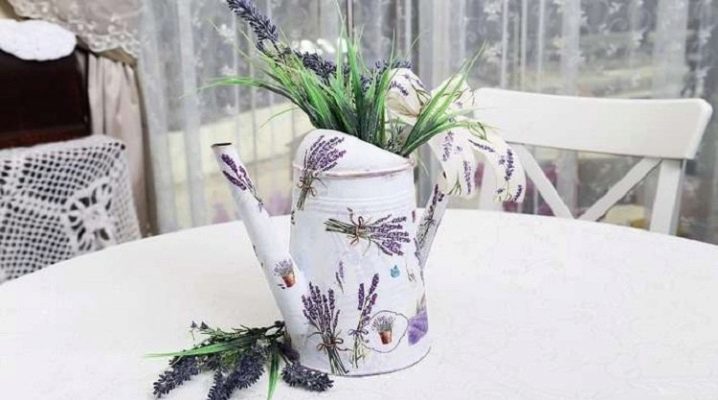
Decoupage is a hit of modern "hand-made". Its popularity is explained by two facts: simplicity of execution and excellent result. In talented hands or with experience, decoupage can become a real art that brings not only pleasure, but also income. In addition, this exciting process is suitable both for those who want to create alone, and for those who want to involve the whole family and friends in joint leisure.
You can start classes with absolutely any household item, plastic or metal. As an example - a master class on decoupage of a garden watering can. A step-by-step algorithm will allow you to create a real pearl in the Provence style. This item is in the house not only among avid gardeners.
You can transform the device for watering indoor plants beyond recognition. Now you don't have to hide it in the closet, on the contrary, the masterpiece will greatly decorate the windowsill or shelf.
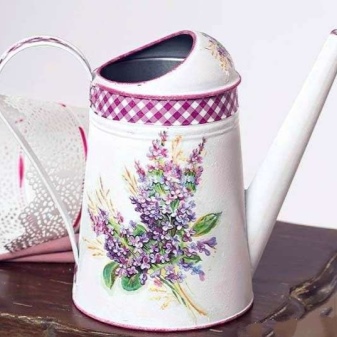
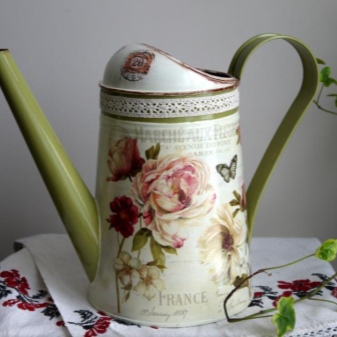
What is decoupage?
Decoupage refers to the technique of applying and fixing on any base any material with a pattern, which is subsequently varnished. As a rule, paper-based material is used. For the base, you can take almost any smooth object with a non-porous surface, without irregularities. For decoupage, both furniture and dishes, decor items, and household items are perfect.
Material on which you can safely decoupage:
- wood in any form: impregnated or not, sanded, unsanded, painted, unpainted, varnished;
- all types of plywood;
- plastic items with any surface: rough and smooth, painted and transparent;
- glass, faience, porcelain;
- metal.

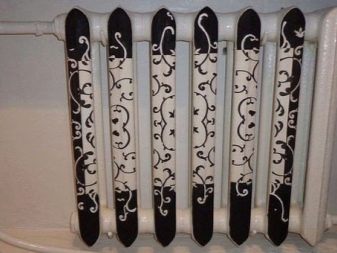
Tools
There is nothing complicated here, most of these items are either in the house, or can be easily purchased at the nearest store:
- small high-quality scissors;
- brushes of different sizes: flat up to 2.5 cm for glue, a sponge or brush of any shape for acrylic, thin - for drawing;
- different sizes of rollers for covering the base;
- palette for connecting different colors, can be replaced with a plate;
- a simple pencil, an eraser, a ruler as needed.
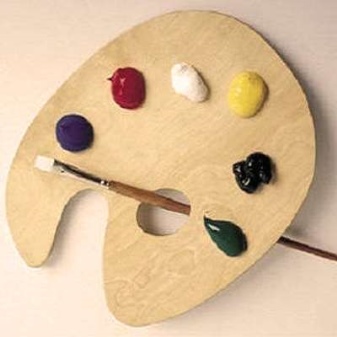
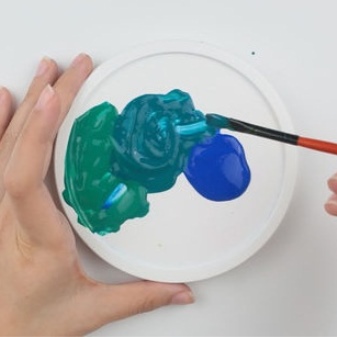
Materials (edit)
In addition to napkins, which are worth mentioning separately, you will need:
- acrylic varnish, it can be ordinary or with the addition of the effect of shimmer, mother of pearl, glitter, craquelure;
- decoupage glue, which successfully replaces standard PVA;
- acrylic paints for final tinting of the overall composition;
- fine or medium-grained sandpaper for sanding wood and eliminating imperfections;
- primer and putty if necessary.

Printed paper or napkins that are glued to the base and varnished can be different:
- most often, napkins with three layers are used, of which only the top one with a pattern is taken - inexpensive, but require skill in work, as they are very fragile;
- a special card on paper for decoupage, which is made on a rice basis - it is very easy to work with it, it stretches well, but expensive;
- decoupage card on a regular paper basis - does not stretch, the price is average;
- photo prints on thin special paper;
- pastes for creating 3D images;
- regular photos without a bottom layer.
For beginners, decoupage paper, a card and regular napkins are suitable.


Features of the Provence style
Since decoupage is one of the techniques of elegant shabby chic, this technique is most often used in the Provencal style. First of all, Provence is a bright contrast to the prim style of the city, it is the freshness of the province, rustic chic, measured and graceful. There are many small details in the style of the French village; it is distinguished by an abundance of decor, floral and floral motives. Therefore, fragments from napkins with flowers and plants are great for this design, especially since white predominates in the Provence style, and this is the most versatile basis for applying decor of any color and shape.
The associative array arising from the word Provence also determines the theme of the decor: landscape, sun, flowering fields, freshly cut hay, spices and herbs. The color scheme is dominated by pastel, muted: pale blue, powdery pink, barely perceptible lemon, mint, lavender, beige, milk, sage, gray. Another distinctive feature of things in the Provencal style is vintage, visual antiquity. Therefore, decoupage things look so good in the interior of Provence - they seem to have come to us from the distant past.

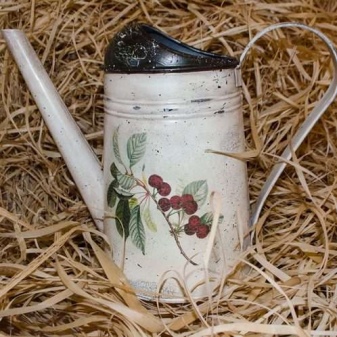
Master classes
Decorating a metal watering can
By itself, this garden item is pretty boring. In order to turn a metal watering can into an elegant, even luxurious object, you will need: brushes, napkins with the selected image, acrylic paints, varnish, glue, and solvent.
The step-by-step algorithm is as follows:
- prepare the base: wash and dry thoroughly;
- degrease with alcohol or solvent, glass cleaner is suitable;
- priming the watering can with white acrylic paint in 2-3 layers;
- apply a layer of paint of the required color for the base of the composition;
- if necessary, we use bituminous varnish to create the impression of an aged thing, it is applied in those places where this effect is needed: seams, pits;
- after a quarter of an hour, we soak a cloth in a solvent and wipe the varnished places, it should not completely dry by this moment;
- free the layer with the image of the picture from the rest of the layers of the napkin;
- we tear off the drawing itself, without clear outlines, but neatly;
- choose a place on the watering can where the image will be located, coat with PVA glue;
- put a napkin on the main side and iron it from the middle to the edges with a brush so as not to break;
- we wait until everything dries up, make the necessary details, adjustments, add strokes, dots, ornaments, lines as needed;
- apply acrylic varnish on the watering can in at least two layers, dry.
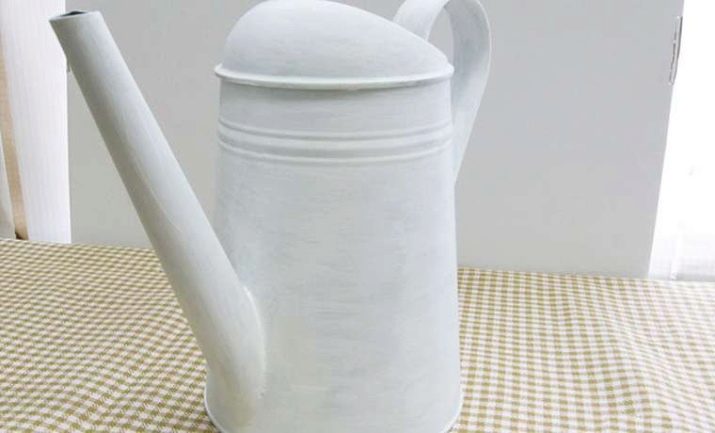

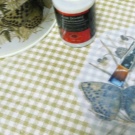
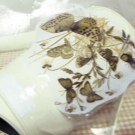
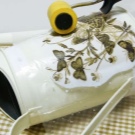
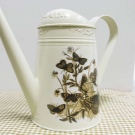
Shabby chic
You will need: acrylic paints, brushes, wax, a watering can and the necessary pattern on napkins.
A watering can is carried out in the style of "shabby" luxury as follows:
- we prepare the base: wash, dry, degrease;
- primed with white acrylic paint;
- we choose the places of aging and after drying with three of them with wax;
- apply the main pigment;
- rub with sandpaper or sandpaper;
- we glue the decor in the same way as in the previous master class;
- we tint with varnish.
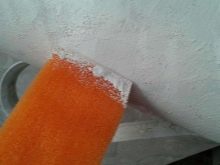
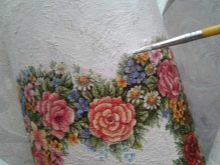
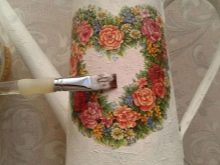
Plastic product design
The procedure for registering a plastic product is as follows:
- prepare the surface, wash it for this, dry it and degrease it with any detergent or alcohol using a sponge;
- we sand the base with fine-grain sandpaper in order to further improve the possibilities for hitching;
- we sand the damaged areas, scratches in the most thorough way;
- primed with acrylic varnish in several layers, at least 20 minutes should pass between their application;
- paint over with the selected pigment and leave to dry;
- apply crackle to pre-selected places, dry the first layer for a quarter of an hour;
- we proceed to the second stage of staining with pigment, you can choose a different shade, let it dry;
- then again the line for craquelure, after which, using a hot hairdryer, dry, characteristic cracks should appear;
- prepare images for decoupage, cut them out, separate the lower layers;
- we apply glue to where the decoupage motive is planned to be placed;
- glue the drawing, iron it with a brush;
- we cover the entire product with acrylic-based varnish, dry it, this procedure must be repeated at least three times;
- we turn over the drawing with thin brushes, making the final touches.
































































The comment was sent successfully.